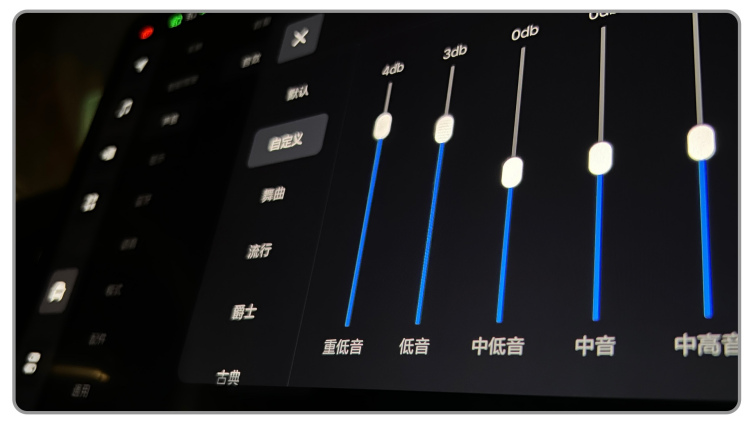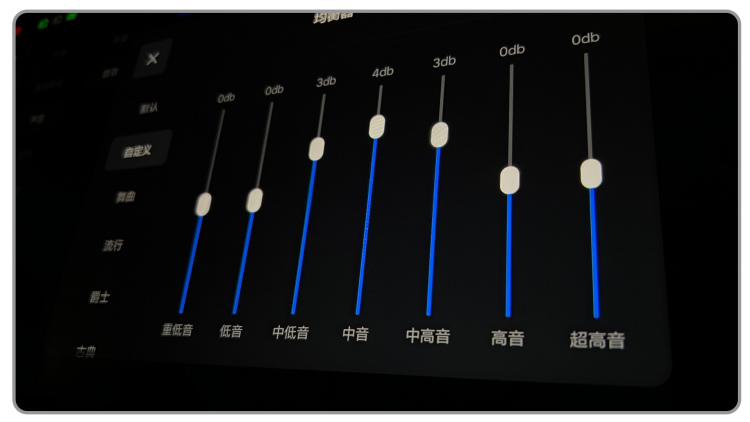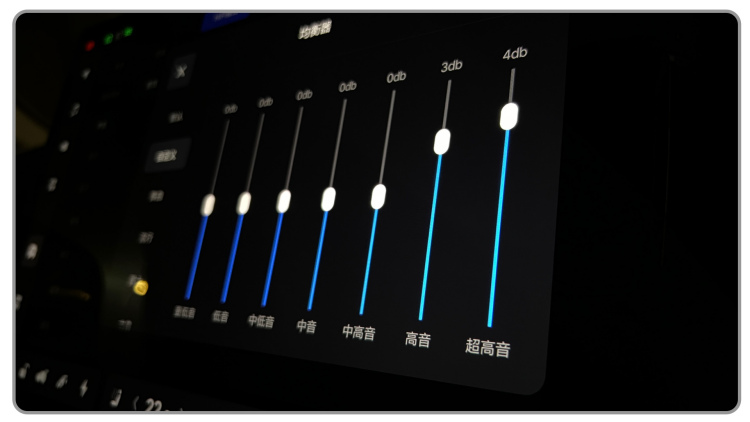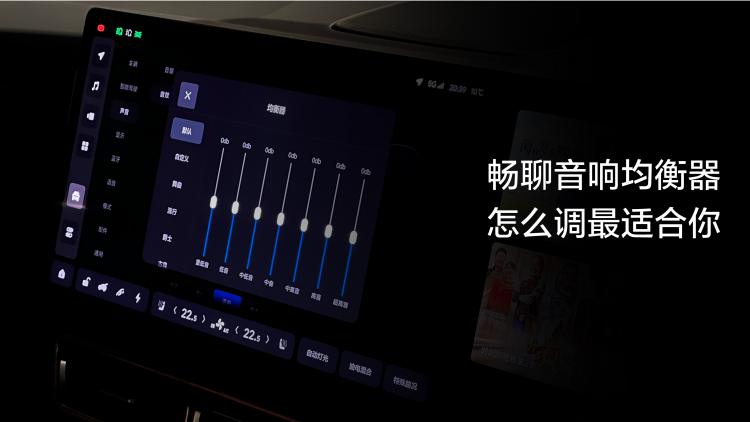If you were to ask which change brought by OTA version 4.1.0 people are most interested in, the switch of the sound system in the Ideal L9 to our proprietary sound effects would certainly rank high on the list.
During the development stage of the sound system, after the sound field, soundstage, and layering have been polished to perfection, you would require software like an equalizer to adjust the sound to suit your auditory preferences.
In today’s article, not only do we recommend my preferred equalizer settings, but we also invite Huang Zheng, Head of Ideal Automotive’s Self-developed Sound System Department, to show you how to adjust your sound system to achieve the sound effect that is perfect for your ears.
A brief discussion on equalizers
Before we talk about equalizers, let’s first understand the aim of sound systems, which can be summed up in one sentence: to authentically restore the world of sound.
Notice the word “authentic.” Does authenticity equate to your favorite sound? Not necessarily. For example, the objective of Apple’s cameras is to restore the most authentic color world. On the other hand, Huawei’s cameras use algorithms to make their photos more visually appealing, hence many people find the photos taken on Huawei phones to be more attractive than iPhone’s photos. However, some people prefer authentic photographs, so it is a matter of personal preference without a “better” or “worse” choice.
Returning to the field of acoustics with the equalizer, an inappropriate metaphor would be that it is like Meitu Xiuxiu in the photograph field. By adjusting the treble, midrange, and bass, it achieves the effect of “photo editing.” It is similar to adjusting the saturation and contrast of a photo; both are aimed at creating a sound or image that you like and satisfying your individual needs for sound, which is the value and function of an equalizer.### Recommended Equalizer Settings
Let me introduce you to my favorite combination of volume, sound effects, and EQ settings.

(I want to remind everyone that the sound algorithm has been switched to a self-developed one, so the previous EQ settings are no longer suitable. To adjust to the current version, feel free to test with the default EQ settings. Additionally, we have optimized the adjustment of the volume. The first 50% of the adjustment is more delicate, while the latter 50% has a larger volume range. The maximum volume remains the same. You can think of the previous version’s volume 35 as the 4.1.0 version’s volume 50.)
After upgrading to the Ideal L9 OTA 4.1.0, I compared various EQ settings with different music genres, and the combination above is what I consider to be more versatile. Whether it’s Chinese-style music, pop, or Western music, it’s comfortable to listen to with a satisfying bass that feels like a massage for your ears. What’s more, the vocals are still bright and clear. Surprisingly, this EQ setting method even improves the sound of movies.
Now, let me recommend 5 demo songs that you can try on both QQ Music and NetEase Cloud Music.

Make sure you test these five songs with the new sound effects, which will give you an entirely new audio experience.
What are the characteristics of low, mid, and high frequencies?
The Ideal L9 equalizer explicitly shows 7 kinds of audio items that can be adjusted, including subwoofer, bass, mid-bass, midrange, mid-high, treble, and ultra-high.
Because the human ear can only hear sounds within a certain frequency range, the sensitivity to low, middle, and high pitches varies. Generally speaking, people are more sensitive to middle pitches. To achieve the same effect as middle pitches, the low and high pitches need to be strengthened.
Therefore, in the past, increasing the volume was a way to achieve better sound quality without an equalizer. This is because raising the overall volume enhances the low, middle, and high pitches and makes the sound fuller to the ear. With an equalizer, the intensity (db value representing gain effect, which can be negative) of the low and high pitches can be adjusted separately, achieving a similar effect to that of increasing the overall volume.
What does it feel like when you hear low pitches? Strong low pitches can cause organs in the body to resonate and make the body move, such as the feeling of buzzing when attending a concert. If we say that there is a wave of sound coming towards us, this refers to low pitches.

Middle pitches are the most frequently encountered audio range in daily life because people’s voices generally fall within the middle pitch range. Singing can reach middle to high pitches, while speaking is in the range of middle to low pitches.

High pitches mainly allow people to hear details and have an amplifying effect, such as the sound of teeth singing when singing. However, if the high pitches are not adjusted properly, they can also be harsh, such as the sound of fingernails scratching a blackboard. Writing this makes me have goosebumps all over my body.
Actually, the cleanliness of everyone’s ear canal also affects their perception of the same audio. This is because of age, too, which affects the sensitivity to high or low pitches.
If we summarize in one sentence, it is that high-pitched sounds are bright, mid-pitched sounds are mellow, and low-pitched sounds are thick.
What changes does self-developed sound effects bring?
So, what changes does the self-developed sound effects bring to the sound effect of the Ideal L9? To answer this question, I talked to Mr. Huang Zheng, the head of the Ideal Automotive’s self-developed audio department, who explained in detail from the following five aspects.
-
Sound Image: The voice is focused on the front center, and the instruments are distributed around it. When listening to music with strong stereo sound, the width of the left and right sides has been extended, restoring the positional information of real music. This is also a very important aspect in most car audio evaluations. Many models cannot meet the requirements because of their shape limitations, and the speaker layout in the car cannot achieve focus and accurate positioning of the sound image. In fact, it is the most difficult part of tuning to solve these focus and positioning problems, to eliminate interference and reflection interference between speakers, and to be compatible with multiple seats. L9 did a series of acoustic simulations in the initial design to ensure the most reasonable speaker layout.
-
Sound Quality: The hierarchy is more clear, high, medium and low-pitch sounds are separated further, and the sound of the drums hits the front and sinks down to the floor, showing more elasticity. The human voice is softer, warmer, and more comfortable to listen to, without feeling discomfort from lip and teeth sounds. The high-frequency details are rich and not harsh, making it more enduring. You can still hear very delicate sounds, such as the clanging or chinking of metal.
-
Surround Sound: The surround mode uses advanced algorithms to separate guitar, vocals, reverb, piano, and applause. When listening to live music, the feeling is very immersive, especially for the second-row seats. You can listen to the live version of Li Jian – Baikal Lake. In the second row, you can feel the vocals in front, harmonies and applause at the back, and instruments spread out on the plane and top, broadening the sound field.- Three-row balance: The HIFI mode now provides equal consideration to each passenger. Before version 4.1, it tended to favor the front row, resulting in a large difference in volume and listening experience between the front and rear rows. Version 4.1 has achieved basic consistency in listening experience and volume between the first two rows while optimizing the listening experience in the third row.
-
High-volume sound quality optimization: In previous versions, high-volume sound was generally reported to be harsh and piercing. Version 4.1 has optimized the sound quality for each level of volume, ensuring that even at maximum volume, it remains comfortable to the ear and pleasant to listen to.
Equalizer adjustment guide
Regarding the adjustment of the seven audio items (Band) on the equalizer, Mr. Huang has also provided guidance:
-
Bands 1 and 2 adjust the thickness of low frequency and vocals, usually adjusted in sync. Band 2 is responsible for strength and thickness, while Band 1 enhances the fullness of low frequency. If you prefer less dispersed low frequencies, increase the adjustment of Band 1. Conversely, if you prefer more strength in the low frequencies, increase the adjustment of Band 2. Increasing Band 2 will enhance the thickness of vocals, including nasal sounds.
-
Band 3 is mainly used to adjust the fullness of vocals and the fundamental frequency of instruments such as guitar strings and resonating sound of the guitar box. Since this version has already improved the equalization at this frequency, it is advisable to reduce the adjustment if you were accustomed to the previous version. If you prefer more prominent vocals, you can increase the adjustment.
-
Bands 4 and 5 are responsible for the brightness of vocals and instruments. If you prefer a bright sound, it is recommended to increase the adjustment moderately. If you prefer a softer sound, then it is recommended to reduce the adjustment. Band 4 is more related to the brightness of vocals, while Band 5 is related to the brightness of instruments.
-
Band 6 is for fricative sounds and relatively harsh sounds. If you prefer a bright and transparent sound, you need to increase the adjustment, but not too much, otherwise the fricative sounds will be too prominent.
-
Band 7 is for details. Increasing the adjustment will enrich the details of vocals and instruments, and enhance the sense of space. If you prefer more atmosphere in live versions, it is advisable to increase the adjustment moderately. If you prefer recording studio quality, it is recommended not to adjust or reduce it moderately.The following is about the self-developed sound effects and equalizer adjustments in this OTA update. We hope everyone can adjust the equalizer that suits them (you can also use my recommended settings to save time) and at the same time gain a better understanding of acoustics. Welcome to leave a comment and exchange ideas in the comment section.
This article is a translation by ChatGPT of a Chinese report from 42HOW. If you have any questions about it, please email bd@42how.com.
